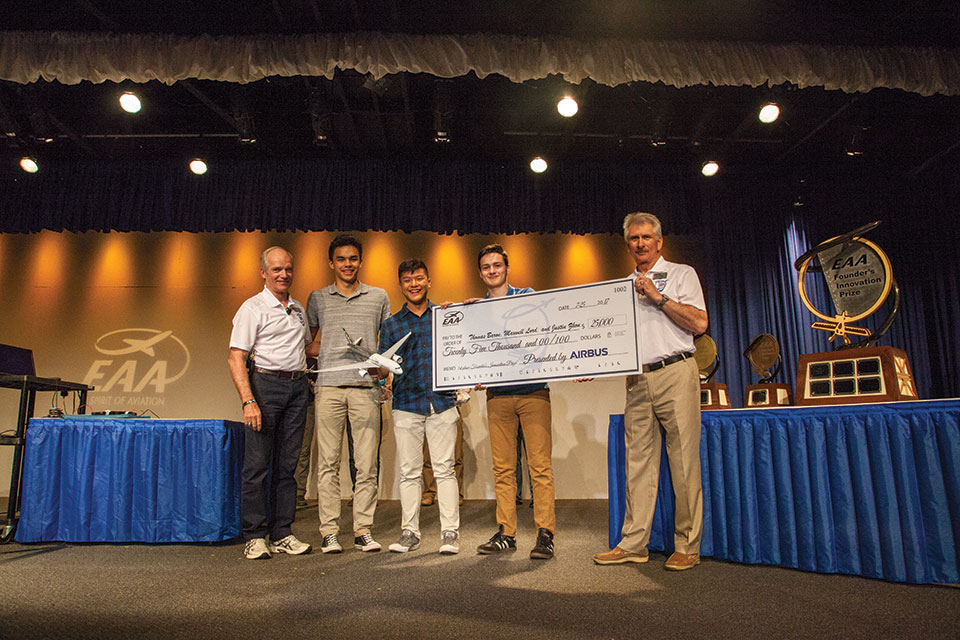Three High School Students Awarded Founder’s Innovation Prize
By Randy Dufault
July 26, 2017 - The premise that the sum is often greater than the parts was demonstrated Tuesday evening at Theater in the Woods when the team of Thomas Baron, Justin Zhou, and Max Lord — high school students from Alexandria, Virginia — accepted the AIRBUS-sponsored top prize in EAA’s Founder’s Innovation Prize competition.
“Who could plan on $25,000?” Thomas said when asked if the team had considered what they might do with the contest’s top prize. “We dreamed about it, but you know ...”
The winning team’s concept, titled “Remora System,” focuses on displaying airspeed and angle of attack on a head-mounted display, which would allow a pilot to continuously monitor those values during flight regimes, especially when looking at the panel is difficult or not recommended. A pod mounted under the wing would provide sensor inputs.
Work on the system began more than a year ago as a class project. Thomas, a flight student and son of a former Navy pilot, was looking for ways to fly at a level of precision that satisfied his father’s exacting requirements.
“Every Saturday we would do pattern work — we didn’t do a lot of cross-country,” Thomas said. “[Dad] thinks that a really good pilot can replicate a pattern perfectly. That’s just from his Navy roots, I think. Basically, being on airspeed, all the time was super important to my upbringing.”
After learning about the competition, the team quickly realized that their project was a perfect fit, and proposals were prepared.
Their presentation was well organized, thanks in part to collaboration with Ihab Awad, the winner of last year’s top prize.
“It was amazing how much effort he put into telling us how the competition worked,” Justin said. “We had no idea. We had never been to Oshkosh. The fact that we are here now is amazing.”
Second place and $10,000 went to Andy Meyer for a concept he calls “Aural Cuing System.” His device, a small box that can be mounted anywhere in an aircraft, provides progressive aural cues as the aircraft approaches attitude regimes where loss of control may be imminent.
Third place and $5,000 went to former astronaut Mike Foale for his “Solar Pilot Guard.” His device attaches to an aircraft wing and feeds differential pressure measurements to a neural network processor. Programming in the processor is specific to the aircraft type so it understands different aircraft energy states, and provides voice cues to the pilot when it detects the potential for loss of control.
Ethan Brodsky’s concept “Buzz Ball” received fourth place. With Buzz Ball, a sensor and processor package provides haptic (buzzing) feedback through the pilot’s seat, reflecting when the aircraft is in an uncoordinated state. By indicating on the left or right side of the seat, a pilot can immediately make corrections that keep the turn coordinator “ball” centered at all times.
Rounding out the finalists was Henry Vos’ submission, “How to Not Fly.” Henry, a flight instructor, believes that making a few simple modifications to the standard airspeed indicator display, and concentrating instruction on keeping the airspeed out of defined yellow and red zones, will make pilots substantially less likely to enter regimes where loss of control can occur.
The finalists had 10 minutes to present their concepts, followed by five minutes of questions from the judging panel.
This year’s panel consisted of Charlie Precourt, a former NASA shuttle commander and chairman of EAA’s safety committee, aerobatic champion Michael Goulian, former NTSB senior air safety investigator Gregory Feith, renowned civilian test pilot Dave Morss, and Van’s Aircraft founder and chief designer Dick “Van” VanGrunsven.
The judges sorted through more than 70 submissions before selecting the five finalists, and Charlie was impressed.
“Comparing last year to this year, the presenters were much more prepared from a technical, in-depth understanding of what they were trying to accomplish, and what the limitations were,” he said. “Each of them showed that they had great, broad knowledge of the capabilities and limitations of their concept.”
Charlie also noticed that collaboration might play a key role in finding solutions.
“The intriguing thing was that as you look at a number of these options, you start to see that if you plug some of them together, and get them to collaborate, it could really jump the bar,” he said. “We’re really going to focus next year on providing a forum for anyone who is thinking about competing, or has already competed, to put their idea out there to collaborate with others and maybe start converging ideas into teamed ideas. Many of them are pretty good standalone [concepts], but you can see where if you combine a couple of them, it would be pretty cool.”

